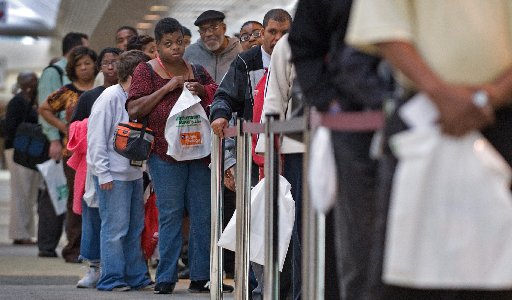
You’ll notice that the featured image for this article about zoning isn’t a map of this or that district plan. It’s people waiting in line for jobs. Whatever jobs they can get.
Generally speaking, zoning is a good thing. By controlling how space is allocated for different types of land use – residential, commercial and industrial – our best community planners can maximize property values, improve the quality of life where we live and work and even make business more profitable than an unregulated market would accomplish on its own. Long sentence, but you get the point.
Notice, we said “generally speaking” as in “most of the time, but not always.” The fact is, zoning is best used for planning new communities that you’re building from scratch and for protecting established neighborhoods from the encroachment of undesirable development. Unfortunately, most of Baltimore is neither of those things.
Baltimore is a city that, 60 years ago, had 950,000 people and now has only 620,000. Over 300,000 people left, mostly from the top down, leaving behind them a city, a third of it empty, strewn with vacant and abandoned properties. A city hanging on by a thread. Twenty-five thousand known unemployed. Easily as many or more working, but not earning a living wage. A quarter of all our families living below the poverty level. A poorly managed city government constantly teetering on the edge of insolvency, having difficulty providing essential services.
When you’re a city in this much trouble, what’s more important: the perfect neighborhood, esthetically speaking, or jobs your people desperately need? When you’re in critical condition, doing whatever’s necessary to save your life is your highest priority, not how you look in those cheap hospital gowns – or whether they tie up in the front or back. For Baltimore, particularly in its most disadvantaged neighborhoods, jobs are paramount. We don’t need master plans, however thoughtful, clever or well-meaning. We need to use the vacant land we have to attract employers to move to these communities pretty much wherever they want.
Short of exposing neighborhoods to toxic waste and other physically harmful land use, the most helpful thing our city planners can do for many sections of Baltimore is rezone vacant properties to accommodate whatever credible sources of employment need to locate there. Don’t plan. Don’t get in the way. Let the market do its thing. Don’t presume that you can anticipate what interested businesses have in mind, because you can’t. Because it’s going to be hard enough for the city to attract employers from around the region and across the country without limiting their options with zoning that isn’t where they want to locate.
Maybe you want zoning in the city’s better neighborhoods and downtown but, for everywhere else where jobs are desperately needed, land use planning can’t be a proactive process. It needs to be reactive. Don’t try to anticipate the market or get inside the heads of businessmen and women who may be open-minded to moving here. The market is in charge. Wait for it and then feed it whatever it wants to eat. Let the market tell you what it needs and make it happen. Give employers whatever vacant property and property tax breaks are necessary to get them to move here – and get out of the way.

